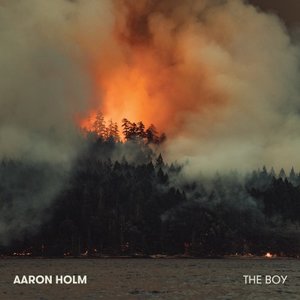Aaron Holm - The Boy (Dissolve Records)
Ambient motifs underscored by uneasy tension on new set by Washington State producer
Released Aug 12th, 2016 via Dissolve Records / By Norman Miller
 Aaron Holm is a Seattle-based producer and musician whose experimental ambient compositions major more on emotional heft than cerebral point-scoring.
Aaron Holm is a Seattle-based producer and musician whose experimental ambient compositions major more on emotional heft than cerebral point-scoring.Influences bubble through at various points: Jon Hopkins; Boards of Canada; Roger & Brian Eno; Loscil; Susumu Yokota. Holm has also been influenced by on-the-road expriences like travelling through SE Asia listening to Future Sound of London and Shinjuku Thief, or taping bird sounds in Brazil's Pantanal. The curious can check out earlier albums – his debut Still Dreaming, or 2014's collaboration with Matthew Felton, Hours.
The cover of The Boy depicts a raging forest fire, dark smoke billowing above the trees. It's an image that suggests this isn't going to be an ambient album intended for chillout. And the best tracks here take a sense of underlying tension and danger as a driver towards the calm that ambient music is so often linked to. Stress and release co-exist in balance.
The title track's drifting ambience is contrasted by bursts of what sound like tinkling sleighbells plus a deep bass tone that hints at anxiety – like a child stepping with both trepidation and excitement through a derelict old building.
Water opens the album with gorgeous Boards of Canada resonant tones but hardens with a dark bass tone deep in the mix, augmented by subtle manipulated handclaps. Wards Island mixes languid oriental-tinged ambience with mid-tempo pulsing and little surges of keening guitar.
The standout track is Broken Kid, featuring a superb piece of improvised poetic musing by Britt Haslett - sounding very like Bjork in her delivery of motivational declamations, weary sighs and lines like “Write about the grief in your bones and how things were before you traced back the origins of your shadows”... It's all set into what sounds like a futuristic motor slowly revving and fading beneath rising and falling slow electronic surges. Breathtaking.
Detached continues the air of existential unease with its dissonant motifs of twisted, not quite identifiable instrumentation wafting over the listener like black smoke from that cover fire.
The context of the closing Catch A Falling Star has garnered attention thanks to its use of a recording of children singing the eponymous song, and its recording around the time of the Sandy Hook elementary school massacre in the States. Its choral wall of female voices is perhaps a necessarily unadorned response to the tragedy of its inspiration.





 All Content RSS Feed
All Content RSS Feed
Follow Bearded on...